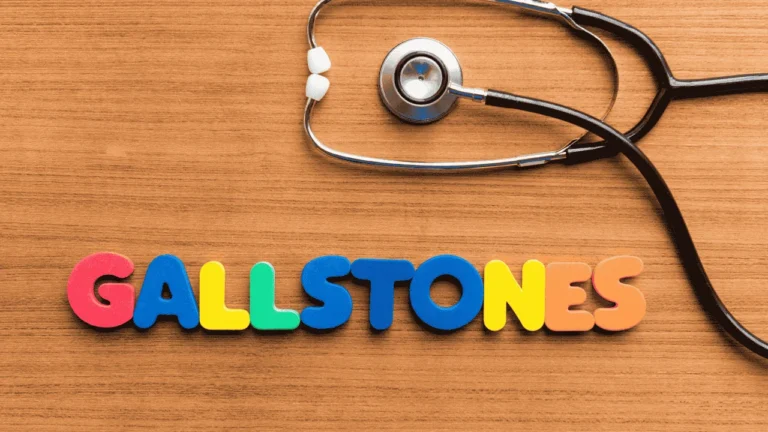Gallstones may not show any harm in the beginning, particularly if you don’t feel any pain. But do you know that untreated gallstones can bring about serious complications in your health? What would begin as a minor problem of digestion could evolve into something fatal if left untouched. Being familiar with the signs of gallstone formation in early stages and complications arising out of untreated gallstones helps avoid long-term health problems.
Table of Contents
What Are Gallstones and Why Do They Form?
Solid particles called gallstones develop in the gallbladder, a tiny organ that stores bile. Bile aids in the digestion of fats, and when bilirubin or cholesterol levels are out of balance, they can crystallize and form stones. Gallstones can range in size from small grains to large stones, and they can either cause no pain or a great deal of discomfort.
Gallstones can seriously harm your digestive system and other organs if they are not treated, particularly if symptoms are present.
Why You Shouldn’t Ignore Gallstones
While others have “silent” gallstones and never experience any symptoms, others will have nausea, bloating, or stabbing pain in the abdomen. If left untreated, gallstones can clog bile ducts and cause infection or inflammation. Even if the symptoms resolve on their own, the condition can quietly progress.
Inactivity with regard to untreated gallstones raises the risk of recurring attacks and potentially serious complications that may need emergency medical treatment.
Complications of Untreated Gallstones
1. Cholecystitis or gallbladder inflammation
Gallbladder inflammation is one of the most frequent side effects of untreated gallstones. It causes fever, excruciating pain, and potentially an infection. In severe cases, surgery might be necessary right away.
2. Obstruction of the Bile Duct
Choledocholithiasis is the result of gallstones obstructing the bile duct. Bile accumulation, liver damage, and severe discomfort are the outcomes of this.
3. The condition known as pancreatitis
The pancreas may become inflamed if a gallstone moves and obstructs the pancreatic duct. Hospitalization is urgently needed for this excruciating and potentially fatal illness.
4. Gallbladder Gangrene or Rupture
As gallstones cut off blood supply to the gallbladder over time, tissue death (gangrene) can result. In extreme cases, the gallbladder can even rupture—a life-threatening condition.
5. Jaundice
Jaundice, where the skin and eyes become yellow because of elevated bilirubin levels, can result from bile accumulation due to untreated gallstones.
6. Digestive Issues
Chronic indigestion, bloating, and trouble digesting fatty foods can also continue, significantly reducing your quality of life.
Who Is at Greater Risk?
Some individuals are more likely to develop gallstones and have complications if not treated. They include:
- Individuals over 40 years
- Women (particularly during or following pregnancy)
- Obese or weight loss individuals
- Diabetics
- Those who consume high-cholesterol diets
If you belong to one or more of these groups, periodic screening and checking on the health of gallbladders is advisable.
Learn more about Risk Factors of Gallstones & How to Prevent Them
When to See a Doctor
Mild digestive discomfort might not appear to be an emergency, but persistent pain, particularly in the upper right abdomen, cannot be neglected. If you experience any of the following, see a healthcare provider:
- Recurring or severe abdominal pain
- Nausea and vomiting
- Fever or chills
- Yellowing of skin or eyes
- Dark urine or pale stools
Early diagnosis and treatment of gallstones can avoid complications that are more difficult to treat later.
Treatment Options for Gallstones
Treatment of gallstones varies with size, location, and symptoms. The most prevalent methods are listed below:
- Medications: Oral bile acids to dissolve stones (rarely used)
- Surgery (Cholecystectomy): Best and most usual treatment
- Endoscopic procedures: To take out stones from bile ducts
Treatment in time removes symptoms and decreases the chance of future complications.
Explore the Best Treatment Options For Gallstones
Prevention Tips for Gallstones
- Eat a high-fiber, low-cholesterol diet
- Avoid skipping meals and lose weight gradually
- Stay hydrated
- Engage in regular physical activity
- Limit fatty and fried foods
Making these small lifestyle changes can reduce your chances of forming new gallstones.
Frequently Asked Questions (FAQs)
1. Do untreated gallstones resolve on their own?
No, untreated gallstones do not usually go away by themselves. Some of them might not cause symptoms, but others may lead to complications if not treated.
2. How do I know whether or not my gallstones need treatment?
If you’re having recurring pain in your abdomen, nausea, or jaundice, then it’s the time to see a doctor. These are typical signs of untreated gallstones.
3. What is the most common complication of untreated gallstones?
Cholecystitis: Gallbladder inflammation is a painful, common complication that often requires emergency care.
4. Do I have to treat gallstones?
Life with untreated gallstones is dangerous. Even if you feel fine, unexpected complications can occur and lead to emergency surgery.
5. Are there non-surgical treatments for gallstones?
Certain medications can dissolve gallstones, but they are not appropriate for everyone. Surgery is generally the best choice, particularly for symptomatic or untreated gallstones.
6. What can I do to prevent gallstones from recurring after treatment?
Eat a healthy diet, exercise regularly, and don’t crash diet. These lifestyle changes can lower your risk of developing new gallstones.
Conclusion
Untreated gallstones may appear harmless at first, but they can escalate into serious complications if left untreated. From painful infections to emergency surgeries, the stakes are too high to ignore. If you have symptoms or have been diagnosed with gallstones, don’t wait—get timely treatment to prevent future health complications.
Act now and seek a doctor’s advice today to prevent complications due to untreated gallstones.




